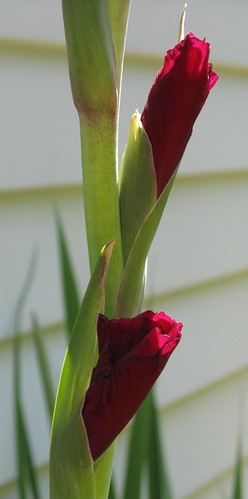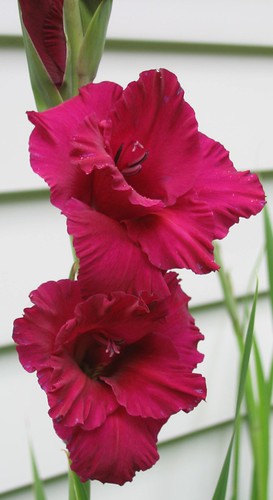Sorta Glad
This spring, as I tidied the yard, I pulled what appeared to be cornstalks. I thought it strange that someone would plant corn in front of the house. The withered, brown leaves easily pulled out of the ground. I assumed that the plant was long dead.
As the season progressed, I began removing the four, ancient yews from in front of the house. Not long into the process, I noticed sturdy shoots emerging from the ground between the two left yews. Curious, I called the former homeowner to ask her what these were. She revealed to me that my “cornstalks” were actually gladiolas. I was surprised because, according to The Gardening Book for Ohio, gladiolas are not hardy and need to be dug up each fall. The previous owner assured me that she had left them in the ground each winter and they emerged each spring.
By the time I had progressed to the third yew, the number of shoots had at least doubled and were in danger of being trampled by my shrub removal efforts. I started digging them up. It was a much more difficult task than I had anticipated. First, they were buried at least 12 inches down. Second, the soil is heavy clay. Third, I had to be careful not to snap the emerging shoots as I pried them from the earth. Last, there were many more bulbs than I had imagined. They had multiplied like rabbits beneath the sticky earth. Determined to save each precious life, I transplanted them with care to a trench at the back of the bed. It quickly reached maximum capacity. I started tucking gladiolas in the garage bed, next to a few other emerging shoots. The ground yielded yet more bulbs. As I ran out of space (and tired of digging new holes) I gave away two heaping pots to my neighbors. I started pitching bulbs into the wild edges of the yard and into the compost pile. At last, I thought I had moved every gladiola from the area and began planting the rest of my garden.
As my soil in the front bed (and almost every other bed) is heavy clay, my planting method involves chopped up clay hunks with a hoe and worked in bag after bag of humus/manure mixture. The result, at times, was a surplus of soil, which I stored in a huge dirtpile on the front walk. All the dirt, eventually, ended back in the bed. Unknowingly, I had also distributed dozens of tiny gladiola bulbs throughout the entire bed.
I have gladiolas EVERYWHERE. Some people weed; I yank baby gladiolas. The bulbs are quite resilient. Even after I’ve pulled multiple leaves from the ground, they keep sending up new shoots. Additionally, the patch I had tried to dig up proved to be much larger than I imagined. I let it be and now have two large gladiola patches in the sun bed. I’ll finish moving them this fall.
I can’t be completely annoyed, though. The plants are incredibly hardy and vigorous. Some of the flower stalks are nearly six feet tall. I find the gladiolas especially hard to hate when they start flowering. *sigh*


Anybody want some bulbs? I’ve got another potful in the garage.
As the season progressed, I began removing the four, ancient yews from in front of the house. Not long into the process, I noticed sturdy shoots emerging from the ground between the two left yews. Curious, I called the former homeowner to ask her what these were. She revealed to me that my “cornstalks” were actually gladiolas. I was surprised because, according to The Gardening Book for Ohio, gladiolas are not hardy and need to be dug up each fall. The previous owner assured me that she had left them in the ground each winter and they emerged each spring.
By the time I had progressed to the third yew, the number of shoots had at least doubled and were in danger of being trampled by my shrub removal efforts. I started digging them up. It was a much more difficult task than I had anticipated. First, they were buried at least 12 inches down. Second, the soil is heavy clay. Third, I had to be careful not to snap the emerging shoots as I pried them from the earth. Last, there were many more bulbs than I had imagined. They had multiplied like rabbits beneath the sticky earth. Determined to save each precious life, I transplanted them with care to a trench at the back of the bed. It quickly reached maximum capacity. I started tucking gladiolas in the garage bed, next to a few other emerging shoots. The ground yielded yet more bulbs. As I ran out of space (and tired of digging new holes) I gave away two heaping pots to my neighbors. I started pitching bulbs into the wild edges of the yard and into the compost pile. At last, I thought I had moved every gladiola from the area and began planting the rest of my garden.
As my soil in the front bed (and almost every other bed) is heavy clay, my planting method involves chopped up clay hunks with a hoe and worked in bag after bag of humus/manure mixture. The result, at times, was a surplus of soil, which I stored in a huge dirtpile on the front walk. All the dirt, eventually, ended back in the bed. Unknowingly, I had also distributed dozens of tiny gladiola bulbs throughout the entire bed.
I have gladiolas EVERYWHERE. Some people weed; I yank baby gladiolas. The bulbs are quite resilient. Even after I’ve pulled multiple leaves from the ground, they keep sending up new shoots. Additionally, the patch I had tried to dig up proved to be much larger than I imagined. I let it be and now have two large gladiola patches in the sun bed. I’ll finish moving them this fall.
I can’t be completely annoyed, though. The plants are incredibly hardy and vigorous. Some of the flower stalks are nearly six feet tall. I find the gladiolas especially hard to hate when they start flowering. *sigh*


Anybody want some bulbs? I’ve got another potful in the garage.


13 Comments:
Suddenly you're the pied piper of glads! They ARE beautiful. And a much better weed than many. :)
I'm jealous. The only plants leftover in my beds are weeds and briars. Fun.
wow! those are beautiful! they'd make great gifts to your friends in simple terracotta pots!
That's my kind of weed. Lovely blooms!
If you have any neighbors you don't like, dress up like a ninja and plant them in their yard at night! In a few years they will have the pleasure of "weeding" them. That way you don't have to feel guilty about killing them and you are spreading the joy to your unsuspecting neighbors. You will be GLAD you did!
Normally glads don't survive the winter in the ground, but occasionally when they are planted close to the foundation, they will survive because the ground is warmer near the house. Lucky you. They are gorgeous.
I love gladiolas. I planted a bunch of purple ones in front of my house. We always had them growing up.
P.O. only had sticky evergreen bushes and tons of tiger lilies around the house when we bought it. Hopefully my lilacs, purple glads, purple peonies and purple pincushion flowers will add more purple to my yard ;)
I actually went to the garden center to see if I could buy some started in pots last weekend and the guy laughed at me. If only I had your problem!
-Amanda
Um, I'm in Cincinnati and would love some gladiola bulbs, especially beautiful crimson ones like your photographs!
I'm near Cincinnati, and I'd love to have a couple in my flowerbed--I really like your photos!
love your photos too, very pretty flowers.
I came across your site while searching for gladiolas. If you still have some I'd love some! I live in the midwest and am trying to start a cut flower farm on a shoestring.
I dug up my glads and planted this spring only to find many more coming up than what I planted. I was shocked. Midwest weather and still had glads. Yeah. It IS close to the house so I may trying not to dig them up this year and see what happens. Will cover with mulch to help.
Post a Comment
<< Home